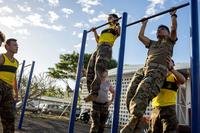I typically group men and women into the same workouts, especially if they are applying for positions in the military, law enforcement or firefighting careers.
My opinion is that women can perform to the same standards as men (they don't have to) with a little extra work and proper training. I have experienced this personally throughout my years of training with 40-year-old moms as well as 20-year-old Navy women. Here is an email from a woman concerning basic fitness/weight loss that will provide some insight to the minor differences/focus points in training programs needed for the genders.
"Is there a difference or different advice you would give to a woman like me who is in her late 30s, who is in moderate shape (I need to lose 20 lbs.) and who is starting all over with her training routine. I have not been able to find a good beginning running program for myself that I can stick to."
As stated above, there is not a major difference between men's and women's fitness needs. We all need cardiovascular exercise for the circulatory system, resistance training for stronger bones and muscles, flexibility to assist with injury prevention and other sports-specific reasons (i.e. for speed). Core strength training is also important for men and women as a foundation to build upper- and lower-body strength, running endurance and better job performance in rigorous professions (such as military and law enforcement).
About the only difference in workouts I provide women, other than the components listed above, is a focus on the basic trouble areas such as inner/outer thighs, legs and stomach. I have found that a steady mix of leg exercises, along with biking or running, can make a huge difference in toning the hips, butt and inner/outer thighs for women. See ideas in the circuit plan below.
For a running plan, the first six weeks below are designed for a beginning runner or for someone who is recovering from an injury:
Running Plan I -- beginning runners
|
Wk. |
Monday |
Tuesday |
|
1 |
1 mile |
Bike or swim |
|
2 |
1.5 miles |
Bike or swim |
|
3* |
Bike or swim |
Bike or swim |
|
4 |
2 miles |
Bike or swim |
|
5 |
2 miles |
2.5 miles |
|
6 |
2-3 miles |
2-3 miles |
|
Wk. |
Wednesday |
Thursday |
Friday |
|
1 |
1 mile |
Bike or swim |
1 mile |
|
2 |
1.5 miles |
Bike or swim |
1.5 miles |
|
3* |
Bike or swim |
Bike or swim |
Bike or swim |
|
4 |
2 miles |
Bike or swim |
2 miles |
|
5 |
off |
2.5 miles |
2.5 miles |
|
6 |
off |
2-3 miles |
2-3 miles |
* Do not run during Week 3; bike or swim every day. Statistically speaking, there is a high risk of injury during the third week of a running program --usually overuse injuries like tendinitis, shin splints or joint aches. For more info on running injuries and prevention, go to www.drpribut.com.
Walk a little/run a little for these distances at first if your cardio fitness is lacking to do these distances nonstop. Before you start running, you should find proper running shoes, stretch daily for 2-3 weeks and start off doing non-impact aerobics before taking your first steps of running.
Being 20 pounds overweight will strain your knees, back, shins and other soft tissues of the body, so get in cardio shape with biking, rowing, elliptical gliding or swimming first. Or just walk at a fast pace.
"Can you give any advice on resistance training with weights and the importance of this to women?"
I like to mix in resistance training 4-5 times a week, with a focus on upper body one day and lower body the next. Some days, you can mix upper- and lower-body workouts together if your training week gets tight. One of the easiest ways to get it done is to use a circuit routine, and you can even mix your cardio/speed work in with it.
See chart below:
|
Upper-Body Workout |
Lower-Body Workout |
Full-Body Workout |
|
Circuit workout (no rest) x2 Pull-ups max reps Dips max Abs max in 2:00 Bench press 50% bodyweight max reps Push-ups max in 1:00 Pulldowns 50% bodyweight (max 3 negatives) Abs max in 2:00 Military press max reps (dumbbells 10-20 pounds) Biceps curls max reps (10-20 pounds) Triceps extension max reps (10-20 pounds) Abs max in 2:00 Bike or run 5-10 minutes easy |
Bike or run/leg PT -- repeat three times -- total 30 minutes -- 5:00 bike at increasing resistance levels for 1:00 at five levels or -- run 5:00 fast 1:00 squats 1:00 lunges (30 seconds each leg) 1:00 heel raises 1:00 jumping jacks 1:00 stretch legs |
Repeat 2-3 times Pull-ups max reps plus Pulldowns 10-15 reps Push-ups 10-20 Squats w/heel raise 20-30 Dips 10-20 Lunges 10-15/leg Crunches 50 of your choice Side crunches 25/side Lower-back swimmer 30 seconds Military press 10-15 Biceps curls 10-20 Triceps extension 10-20 Hammer curls 10-20 1/2 sit-ups max in 2:00 Lightweight shoulder routine |
References:
Resistance training with weights or calisthenics and adding in abs and lower-back exercises is vital for men and women. By adding resistance training, you will strengthen bones, tone and strengthen muscles, and increase metabolism. As far as pull-ups, the common denominator between men and women who can perform pull-ups and other hard, upper-body exercises, is that they practice pull-ups and other exercises like dips, push-ups and bench press.
I have trained 40-year-old mothers of four to do 8-10 pull-ups simply by adding pull-ups to their world. It helps not to be 20-40 pounds overweight when doing any body-weight exercise, and men and women can use that advice.
"How do you feel about supplements that suppress the appetite and speed up the metabolism?"
I am not a big fan of supplements, especially diet pills or suppressants. Eating well is all you need to meet the needs of your body during exercise routines. However, I am aware that life can get in the way of eating well, so if you cannot follow the plan above (on some days), add another liter of water to an afternoon meal replacement bar like Power Bar or SlimFast meal replacement bars (cookie dough flavor even passes my 4-year-old son's taste buds). These offer vitamins, minerals, protein, carbs and limit fat, so they are good for you if you have to replace a vegetable wrap or whole- wheat pasta salad with something easy.
Related article:
Stew Smith is a former Navy SEAL and fitness author certified as a Strength and Conditioning Specialist (CSCS) with the National Strength and Conditioning Association. Visit his Fitness eBook store if you're looking to start a workout program to create a healthy lifestyle. Send your fitness questions to stew@stewsmith.com.
Want to Learn More About Military Life?
Whether you're thinking of joining the military, looking for fitness and basic training tips, or keeping up with military life and benefits, Military.com has you covered. Subscribe to Military.com to have military news, updates and resources delivered directly to your inbox.


















